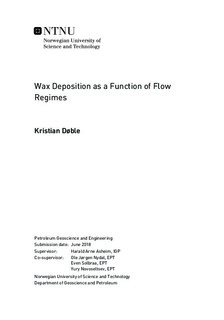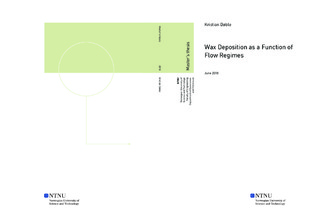| dc.description.abstract | As petroleum fluids flow in subsea pipelines, the fluids are cooled by the surrounding water. Many crude oils contain substantial amounts of wax molecules, and if the temperature of the fluids drops below the Wax Appearance Temperature(WAT), wax will precipitate and can deposit on the pipe wall. If the deposition is left untreated, the effective pipeline diameter will decrease, resulting in a reduction in flow capacity. In cases where the production is stopped without heating or insulation of the pipe, the wax deposit can completely plug the pipe.
Wax deposition during multiphase flow is not well understood, and only a few experimental studies has been conducted. 17 tests were therefore conducted using a multiphase flow rig at NTNU, where air and waxy oil were used as gas and liquid phase. Constant air rate was used, and different flow regimes were achieved by varying the oil rate. After each test, the wax deposition thickness and porosity were measured, and pictures were taken inside the copper pipe to determine the deposition pattern.
During stratified flow the wax deposited only on the bottom part of the pipe, and the wax thickness increased with increasing oil fraction, because more of the pipe was wetted.
Observations revealed that the thickest wax deposition was found in the transition region between stratified and slug flow, called wavy stratified flow. Here, the wax deposited in the bottom part of the pipe, but also on the top part of the pipe due to small droplets leaving the stratified flow, and instantaneously deposited when hitting the cold pipe wall.
During slug flow, the wax deposited around the whole pipe circumference, as the pipe wall was completely wetted. However, the wax thickness decreased with increasing oil rate due to the shear removal effect where already deposited material was mechanically removed by the flowing fluid.
Pictures taken inside the copper pipe after each test confirmed that some of the wax deposited due to gravity settling. This contradicts the common belief among researchers where deposition due to gravity settling is normally assumed negligible. | |

